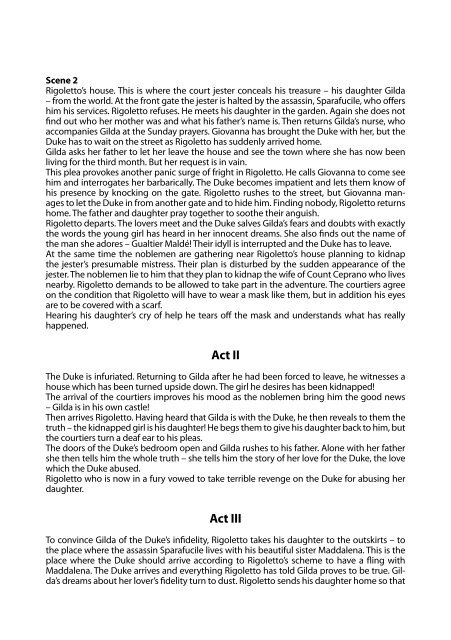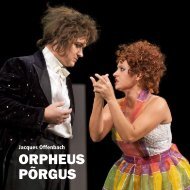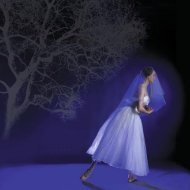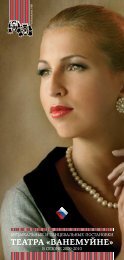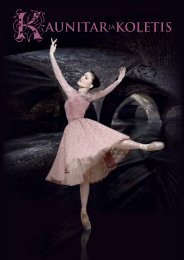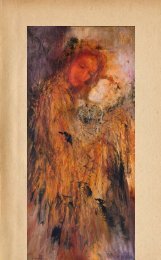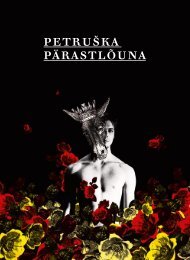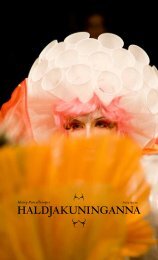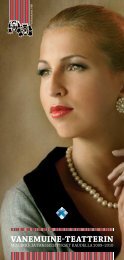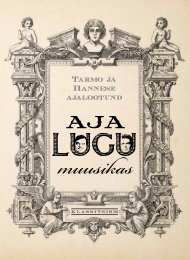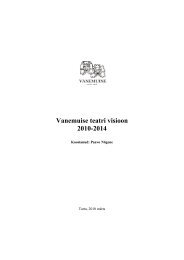You also want an ePaper? Increase the reach of your titles
YUMPU automatically turns print PDFs into web optimized ePapers that Google loves.
Scene 2<br />
<strong>Rigoletto</strong>’s house. This is where the court jester conceals his treasure – his daughter Gilda<br />
– from the world. At the front gate the jester is halted by the assassin, Sparafucile, who offers<br />
him his services. <strong>Rigoletto</strong> refuses. He meets his daughter in the garden. Again she does not<br />
find out who her mother was and what his father’s name is. Then returns Gilda’s nurse, who<br />
accompanies Gilda at the Sunday prayers. Giovanna has brought the Duke with her, but the<br />
Duke has to wait on the street as <strong>Rigoletto</strong> has suddenly arrived home.<br />
Gilda asks her father to let her leave the house and see the town where she has now been<br />
living for the third month. But her request is in vain.<br />
This plea provokes another panic surge of fright in <strong>Rigoletto</strong>. He calls Giovanna to come see<br />
him and interrogates her barbarically. The Duke becomes impatient and lets them know of<br />
his presence by knocking on the gate. <strong>Rigoletto</strong> rushes to the street, but Giovanna manages<br />
to let the Duke in from another gate and to hide him. Finding nobody, <strong>Rigoletto</strong> returns<br />
home. The father and daughter pray together to soothe their anguish.<br />
<strong>Rigoletto</strong> departs. The lovers meet and the Duke salves Gilda’s fears and doubts with exactly<br />
the words the young girl has heard in her innocent dreams. She also finds out the name of<br />
the man she adores – Gualtier Maldé! Their idyll is interrupted and the Duke has to leave.<br />
At the same time the noblemen are gathering near <strong>Rigoletto</strong>’s house planning to kidnap<br />
the jester’s presumable mistress. Their plan is disturbed by the sudden appearance of the<br />
jester. The noblemen lie to him that they plan to kidnap the wife of Count Ceprano who lives<br />
nearby. <strong>Rigoletto</strong> demands to be allowed to take part in the adventure. The courtiers agree<br />
on the condition that <strong>Rigoletto</strong> will have to wear a mask like them, but in addition his eyes<br />
are to be covered with a scarf.<br />
Hearing his daughter’s cry of help he tears off the mask and understands what has really<br />
happened.<br />
Act II<br />
The Duke is infuriated. Returning to Gilda after he had been forced to leave, he witnesses a<br />
house which has been turned upside down. The girl he desires has been kidnapped!<br />
The arrival of the courtiers improves his mood as the noblemen bring him the good news<br />
– Gilda is in his own castle!<br />
Then arrives <strong>Rigoletto</strong>. Having heard that Gilda is with the Duke, he then reveals to them the<br />
truth – the kidnapped girl is his daughter! He begs them to give his daughter back to him, but<br />
the courtiers turn a deaf ear to his pleas.<br />
The doors of the Duke’s bedroom open and Gilda rushes to his father. Alone with her father<br />
she then tells him the whole truth – she tells him the story of her love for the Duke, the love<br />
which the Duke abused.<br />
<strong>Rigoletto</strong> who is now in a fury vowed to take terrible revenge on the Duke for abusing her<br />
daughter.<br />
Act III<br />
To convince Gilda of the Duke’s infidelity, <strong>Rigoletto</strong> takes his daughter to the outskirts – to<br />
the place where the assassin Sparafucile lives with his beautiful sister Maddalena. This is the<br />
place where the Duke should arrive according to <strong>Rigoletto</strong>’s scheme to have a fling with<br />
Maddalena. The Duke arrives and everything <strong>Rigoletto</strong> has told Gilda proves to be true. Gilda’s<br />
dreams about her lover’s fidelity turn to dust. <strong>Rigoletto</strong> sends his daughter home so that<br />
she will dress up like a man and go to Verona. He will follow her the next day.<br />
<strong>Rigoletto</strong> pays Sparafucile half the money he asked for killing the Duke. He will receive the<br />
other half after murdering the Duke.<br />
Maddalena tries to convince her brother to spare her lover’s life and tells him that he could<br />
kill the hunchback who will come to bring the rest of the money. But this proposal is against<br />
her brother’s code of honour and he refuses, admitting that if a stranger were to arrive on this<br />
stormy night he would be willing to kill the stranger instead of his sister’s lover.<br />
Gilda who has now returned overhears the conversation and decides to save the life of the<br />
man she loves by sacrificing her own. Gilda knocks on the door, she enters and she is killed.<br />
<strong>Rigoletto</strong> returns. Having handed over the rest of the money he is given a body wrapped in a<br />
basswood mat. This can be nobody else but the man who disgraced his daughter – the Duke<br />
of Mantua!<br />
He starts pulling the bundle to the final resting place of his hated master – towards the river<br />
– when he hears how his master light-heartedly leaves his last conquest’s house.<br />
Refusing to believe what he has heard and seen, he opens the bundle and finds his daughter<br />
there, stabbed. The Monterone’s curse had come true!<br />
„Verdi ja <strong>Rigoletto</strong>“<br />
Giuseppe Fortunino Francesco Verdi on sündinud oktoobris 1813 toona prantslaste poolt valitsetavas<br />
Parma hertsogiriigis Le Roncoles ja surnud 27. jaanuaril 1901 Milaanos. Ta pärines<br />
lihtsast perekonnast. Verdi erakordne anne avaldus väga varakult ja lähedal asuva Busseto<br />
organist andis talle esimest muusikalist õpetust. Kaupmees Antonio Barezzi toetusel asus<br />
ta 1823 õppima kohalikus gümnaasiumis. Milaano konservatooriumi Verdit 1832 paraku ei<br />
võetud, aga jällegi Barezzi toetusel sai temast Vincenzo Lavigna eraõpilane. 1832. aastast<br />
oli Verdi Bussetos organist ja 1836 muusikadirektor. Samal aastal abiellus ta Barezzi tütre<br />
Margheritaga (mõlemad sellest abielust sündinud lapsed surid paraku varakult). Neil aastatel<br />
õppis Verdi mitte üksnes kontrapunkti ning ooperikirjutamise aluseid, vaid tegeles ka poliitika<br />
ja kirjandusega.<br />
1838 läks Verdi uuesti Milaanosse. Märtsis 1839 kanti Milano La Scalas edukalt ette tema<br />
ooper Oberto, conte di San Bonifacio. Tema järgmine teos, koomiline ooper Un giorno di regno<br />
(1840) vilistati välja. Selleks ajaks oli Verdi lisaks lastele kaotanud ka oma noore naise ning<br />
otsustas masendunult komponeerimise lõpetada.<br />
Veidi enam kui aasta pärast suutis La Scala direktor teda veenda kirjutama veel üks ooper<br />
„Nabucodonosor“ (1842; hiljem nimetatud Nabucco). Sellest ooperist sai sensatsioon ning<br />
Verdist Itaalia ooperielu kangelane. Vangistatud juutide koorist Va, pensiero, sull’ali dorate sai<br />
Austria poolt okupeeritud Lombardias poliitiline hitt: itaallaste vabaduse- ja iseseisvusetahe<br />
leidis muusikalise väljenduse. Avalikkus tõlgendas seda ooperit kui allegooriat itaallaste võitlusest<br />
võõrvõimude vastu.<br />
Järgneva kuue aasta jooksul kirjutas Verdi elatise teenimiseks rea oopereid: I Lombardi alla<br />
prima crociata (1843) ja Ernani (1844) olid edukad. Järgnevatest on aga üksnes Macbeth<br />
(1847) ja Luisa Miller (1849) suurte ooperiteatrite standardrepertuaari jõudnud. La battaglia<br />
di Legnano (1849) oli Verdi vastus „risorgimentole“, Itaalia ühendamise liikumisele, mis järgnes<br />
revolutsiooniaastale 1848. Enda sõnul komponeeris ta tol ajal kui galeeriori ja pani oma<br />
tervise tõsiselt hädaohtu. Verdi selgeks sihiks oli koguda piisavalt vahendeid, et soetada maa-


